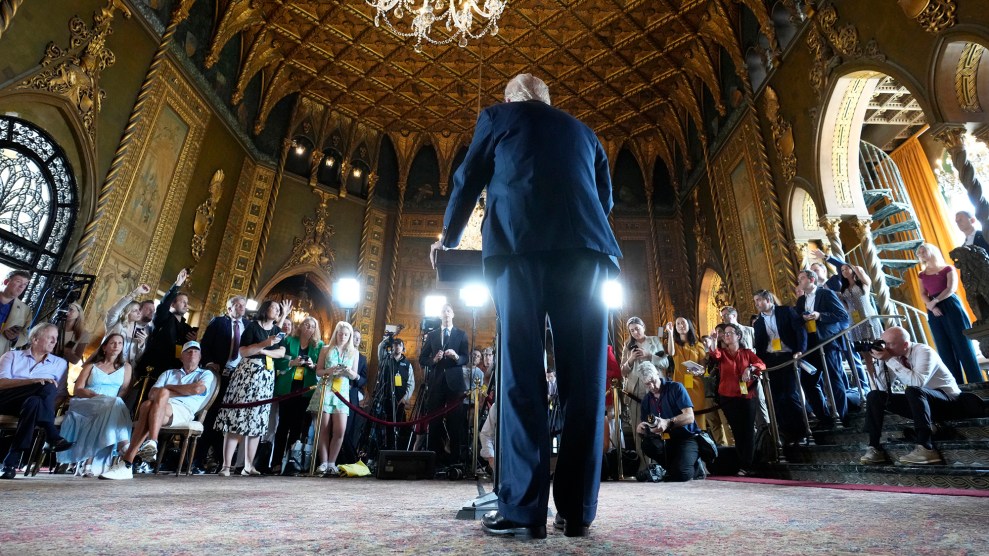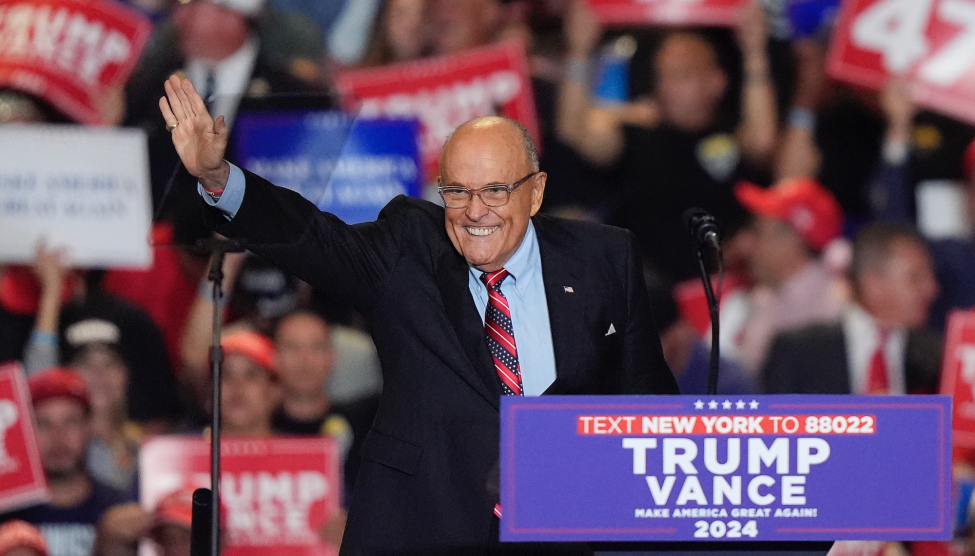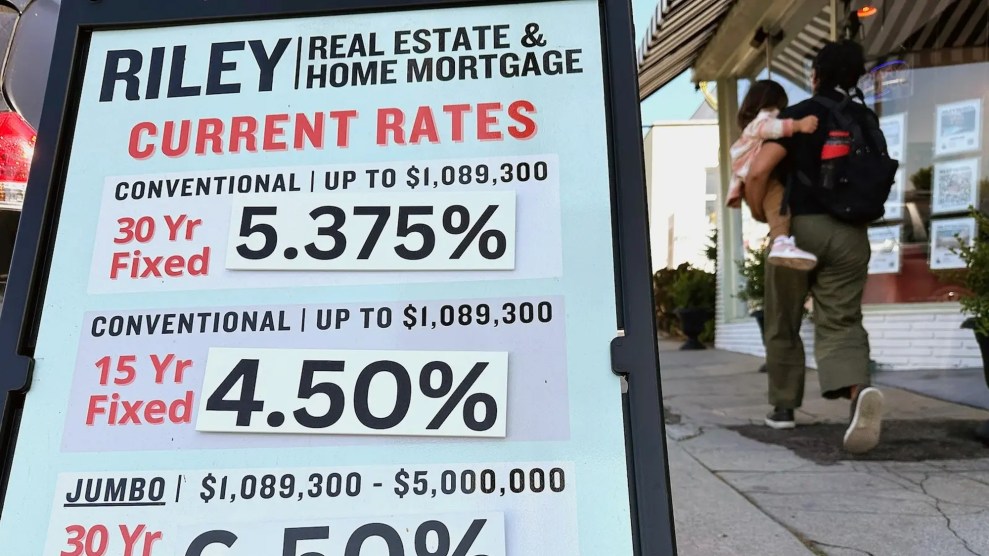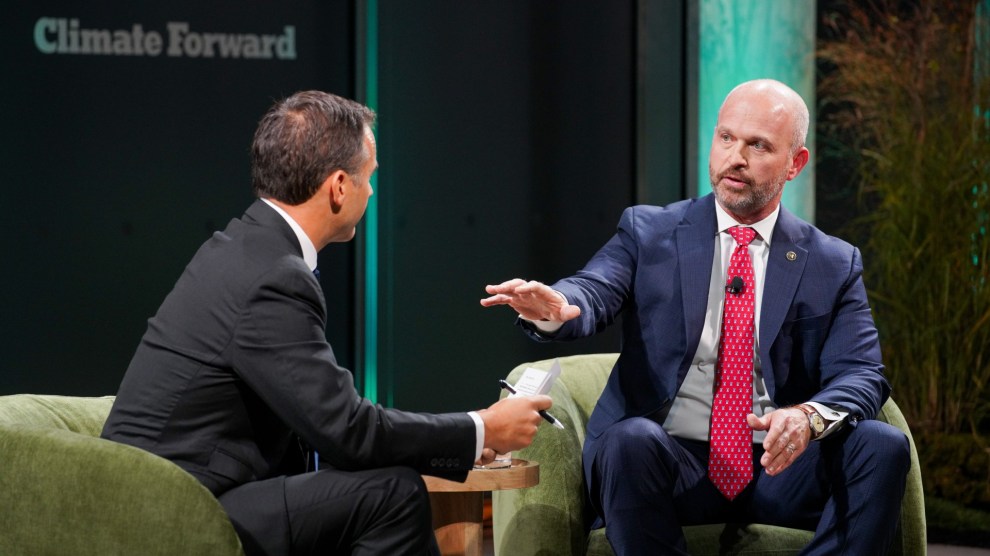
Mother Jones illustration; Emily Elconin/Getty; Getty(3)
Mormons would probably be psyched. The Republican Party less so.
I’m talking about what would happen if we embraced the idea, proposed by Donald Trump’s running mate, Ohio Sen. JD Vance—isn’t he funny?—of empowering families by giving parents of young children an extra vote for each child.
Besides being likely unconstitutional (see the unanimous 2016 Supreme Court ruling in Evenwel v. Abbott, which upheld the 14th Amendment principle of “one person, one vote”) such a policy would be difficult to implement. Who gets the extra votes if there’s an odd number of kids and/or the parents are estranged or have opposing views? Who votes on behalf of stepkids—do they count? Adoptees? How about kids living with their grandparents? Noncitizen parents? Parents with Green Cards? Could undocumented parents vote on behalf of US-born offspring? And how would you verify all of it?
To be fair, in an interview over the weekend, Vance clarified that his proposal was simply a “thought experiment.” Okay then! Let’s think it through.
Assuming this proposal were legal and workable, whom would it benefit? Certainly the Mormons, who are known for prolific procreation (in 2014, according to a Pew Research report, Mormon couples ages 40-59 had an average of 3.4 children vs. 2.2 for all Christians and 2.1 nationally—they also famously have a history of having too many spouses.) Mormons tend to be conservative and vote Republican. But only about 1.2 percent of Americans identifed as Mormons in 2022, per the Washington Post. So who else might benefit?
Predicting voter preference and its impact on a given race is complicated and involves various interrelated factors: One must consider a given group’s cohesiveness, political tendencies, and likelihood of turnout, in addition to age, education, income, and geographical concentration—for example, Michigan’s Somali diaspora, Hawaii’s large Pacific Islander population, and Mexican Americans in the Southwest.
America’s young parents are more ethnically diverse than the broader population, and most minority groups lean Democratic—but turnout wold be key.
To these factors we can now add fecundity.
To make sense of all this stuff, you’d need a pro, so I called up William H. Frey, a senior fellow at the Brookings Institution and US Census expert who has researched urban populations, migration, immigration, race, aging, and political demographics. He’s also the author of the 2018 book, Diversity Explosion: How New Racial Demographics are Remaking America.
I also poked around for useful data. The Census Bureau’s 2023 Current Population Survey breaks down, by race and income, households with children under 18. That’s useful, because income is a rough proxy for education, and families with less education tend to have more children, Frey told me.
Non-Hispanic whites are significantly under-represented among parent households with incomes of less than $75,000—which account for 38 percent of all families with young children—while Latinos are substantially over-represented. In the slightly larger and more educated middle tier, households with $75,000-$199,999 in income, Asians and non-Hispanic whites are slightly over-represented while Black and Hispanic households are slightly under-represented. In the high-income tier ($200,000-plus), non-Hispanic whites and Asians are strongly over-represented while Black and Hispanic households are strongly under-represented—but only 17 percent of all families with young kids fall into this high-income, high-education, and likely high-turnout group.
The US has 3.5 million non-Hispanic, mixed-race kids, whom Trump managed to insult by asking, of Kamala Harris, “Is she Indian or is she Black?”
Slice and dice as you will, the upshot is that America’s youth, and their parents, are more ethnically diverse than the broader population. Non-Hispanic whites are 58 percent of the population, but less than half of kids under 18 are white only. Fourteen percent of kids are Black only, echoing the Black share of the US population. Ditto Asian kids (6 percent vs. 6.5 percent). But Latinos, representing 19.5 percent of the overall population, account for more than a quarter of minor children.
As of last year, non-Hispanic white families had 35.2 million minor children, whereas Asian, Black, and Latino families—all groups that tend to vote Democratic, Frey says—had 33.4 million children combined. (There were also 3.5 million non-Hispanic mixed-race kids—whom Trump may have managed to insult by asking, of Kamala Harris, “Is she Indian or is she Black?” Because one can’t be both!)
Trump’s supporters tend to be older and whiter, whereas most voting-eligible parents of young children would fall into the 25-44 age categories, which are more ethnically diverse, as this chart Frey put together demonstrates. (Scroll over the bars for exact percentages.)
Given our Electoral College rules, geographical clustering matters for the presidential race. Ethnically diverse states such as Texas and California, as Frey points out, "are going to have a bigger share of their voting age population with children and minority children. So that can help bolster the minority vote." Also, a sizeable share of America's Black population resides in red and purple states. And again, minority voters tend to favor Democrats.
"The key issue is turnout," Frey says. "High turnout is largely old people, college educated whites. Not so much for young people. And not so much for most minorities, except in some elections, like when Obama was running." (Note: This could be one such election.)
There's also an X-factor to consider: Might the promise of extra votes serve as an incentive for parents who might not otherwise do so to get out and exercise their patriotic duty, potentially narrowing ethnic and educational turnout disparities?
Frey was too busy to help me conduct an official analysis, but his overall impression is that Vance's idea would likely benefit Democratic candidates and priorities. "The whole thing is a bit hard to execute anyway," he says with a laugh. "Who’s gonna check? They accuse everybody of voter fraud if they just do normal voting. What happens if they do this kind of thing?"













